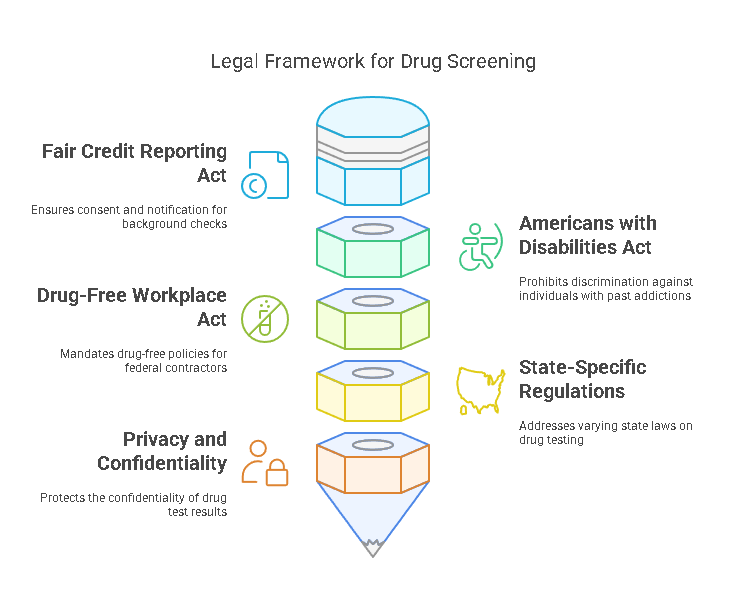Everything You Need to Know About 5-Panel Drug Screening
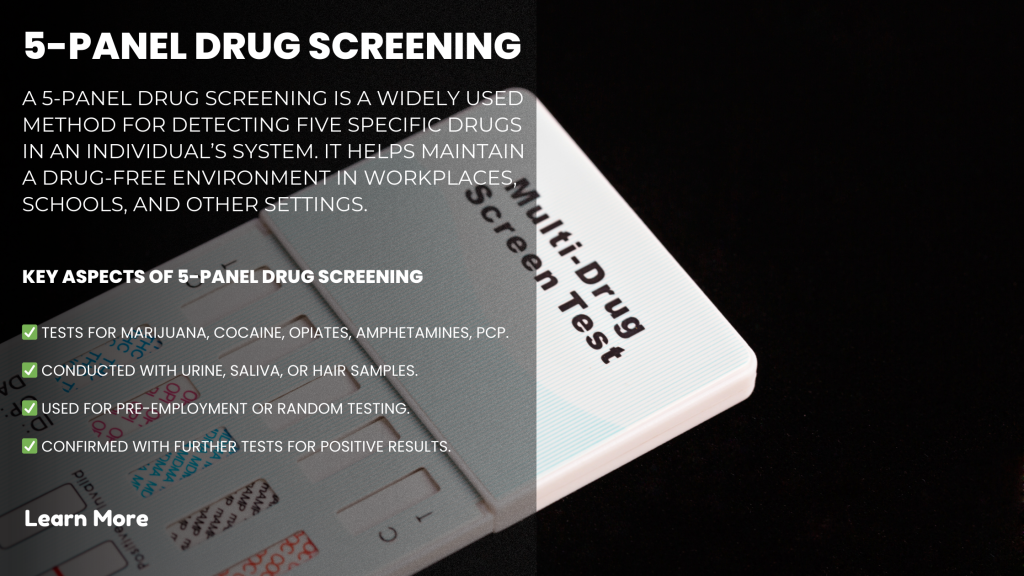
Understanding 5-Panel Drug Screening: What It Is and How It Works
5-panel drug screening is a critical process used by employers, law enforcement, and healthcare providers to ensure a drug-free environment. It is one of the most common types of drug tests, particularly used for employment screening, compliance with regulations, and ensuring public safety. Whether it’s used to maintain workplace safety, screen potential employees, or detect substance abuse in certain legal contexts, the 5-panel drug screening plays a key role in these situations.
In this section, we will explore the basics of 5-panel drug screening, including how it works, why it is used, and the substances that are tested. Understanding these components is crucial for employers, employees, and anyone involved in the process, as it helps to make informed decisions about the relevance and importance of drug screening.
What is 5-Panel Drug Screening?
A 5-panel drug screening is a specific type of drug test that checks for five commonly abused substances. These substances are marijuana (THC), cocaine, opiates (such as morphine or heroin), amphetamines (such as methamphetamine), and phencyclidine (PCP). This type of test is a standard choice in many settings, especially in workplaces where safety is a concern or where employees operate heavy machinery or handle sensitive information. It is widely used in the hiring process for various industries, as well as for post-accident screenings and random drug testing during employment.
The 5-panel test is known for its reliability, affordability, and ability to detect these key substances. Although some employers may opt for more comprehensive tests, such as the 10-panel or 12-panel drug tests, the 5-panel test remains the preferred choice due to its ability to detect the most commonly used illicit drugs.
Why is 5-Panel Drug Screening Used?
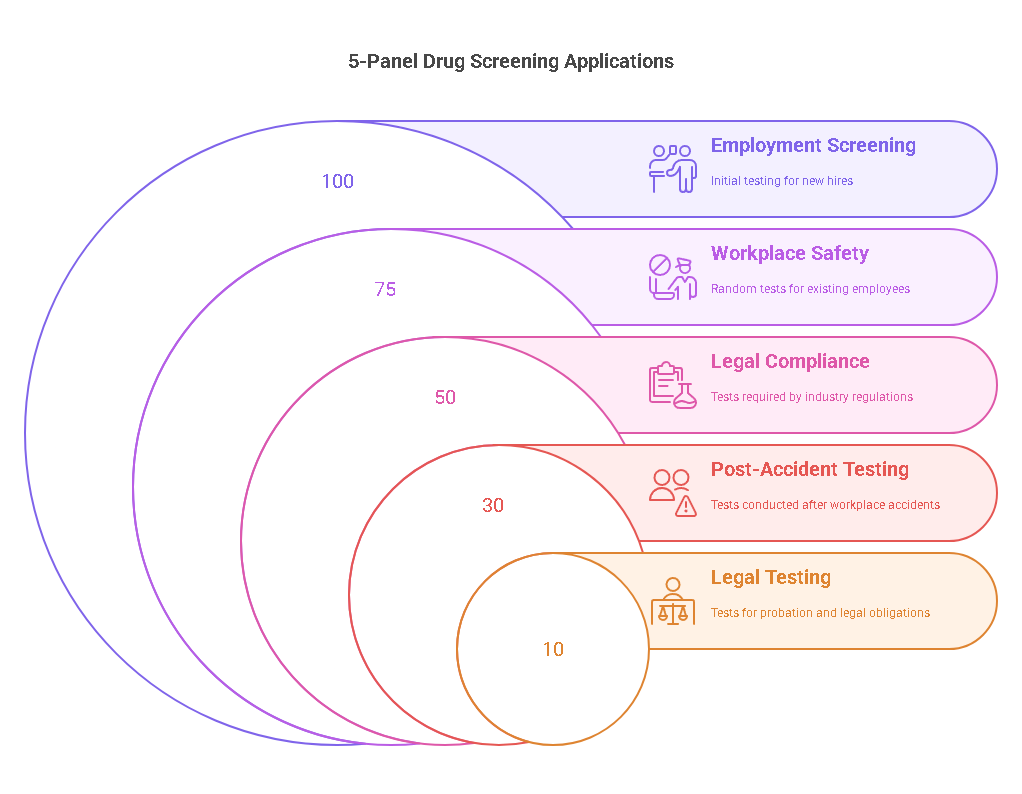
5-panel drug screenings are used for several important reasons. Below are the key areas where these tests are commonly applied:
1. Employment Screening
One of the primary uses of 5-panel drug screening is in the employment process. Employers in safety-sensitive industries, such as construction, transportation, healthcare, and manufacturing, rely on drug testing to ensure that their employees are not under the influence of drugs while on the job. Drug use can impair judgment, motor skills, and overall job performance, which can have serious consequences in certain fields.
Before hiring new employees, employers often require a drug test as part of their pre-employment screening process. Additionally, some companies conduct random drug tests on their existing workforce to ensure compliance with workplace drug policies. These screenings can help mitigate risks, prevent workplace accidents, and ensure that employees are fit for duty.
2. Workplace Safety
In many workplaces, ensuring that employees are not under the influence of drugs while performing their duties is a matter of safety. Employees who are impaired by drugs pose a significant risk to themselves, their coworkers, and the organization as a whole. For instance, workers operating heavy machinery or driving vehicles must be sober and focused at all times to avoid accidents.
Random drug testing and post-incident drug screenings are often used in high-risk environments to minimize the chances of drug-related accidents. By conducting 5-panel drug screenings, employers can maintain a safer and more productive workplace.
3. Compliance with Legal Regulations
Certain industries are subject to strict regulatory requirements concerning drug testing. For example, the Department of Transportation (DOT) mandates drug testing for employees working in transportation-related jobs, including truck drivers, train operators, and airline staff. These regulations are in place to ensure the safety of the public and prevent accidents caused by drug use.
In such industries, employers must conduct regular drug testing, which often includes 5-panel drug screens. Compliance with these regulations is essential for maintaining a license to operate and avoiding legal penalties.
4. Post-Accident Testing
In the event of a workplace accident, employers may require drug testing as part of the investigation process. The goal is to determine whether substance abuse played a role in the incident. Post-accident drug testing can help protect the company from liability and ensure that safety protocols are being followed. Additionally, it can help identify employees who may need help with substance abuse problems.
5. Legal and Probationary Testing
In addition to workplace use, 5-panel drug tests are often required by law enforcement or the court system for individuals on probation, parole, or those involved in legal proceedings. Testing for drug use in these situations ensures that individuals are complying with court orders or probationary terms. This type of drug testing is crucial for maintaining accountability and helping individuals stay drug-free as part of their rehabilitation or legal obligations.
How Does 5-Panel Drug Screening Work?
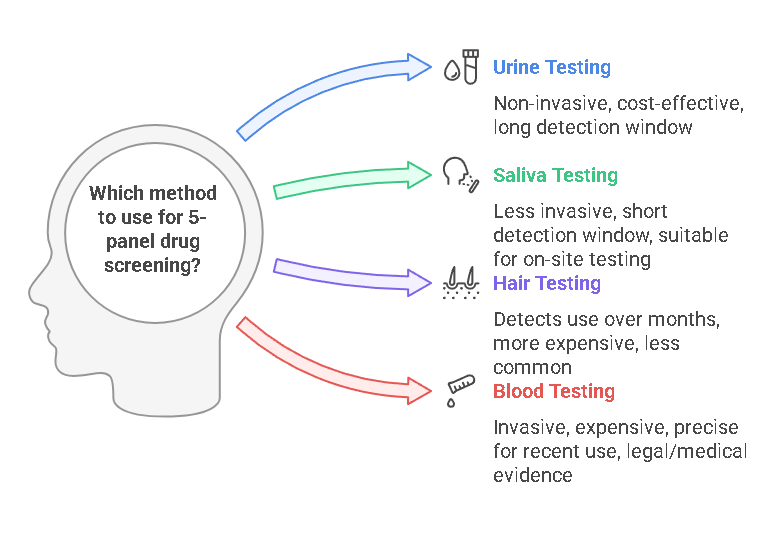
The process of administering a 5-panel drug screening varies depending on the method of testing chosen. The primary methods for drug testing are urine testing, saliva testing, hair testing, and blood testing. Each of these methods has its own benefits, detection windows, and challenges.
Urine Testing
Urine testing is the most widely used method for 5-panel drug screenings. It is popular because it is non-invasive, cost-effective, and can detect drug use over a longer period. Typically, a urine sample is collected in a controlled setting, where the person being tested provides the sample in a private restroom or testing facility. Once the sample is collected, it is sent to a laboratory for analysis. The lab tests for specific metabolites, which are byproducts of drugs that are present in the body after the drug is consumed.
Urine tests are capable of detecting drug use over a period ranging from a few days to several weeks, depending on the substance and the individual’s usage patterns.
Saliva Testing
Saliva testing is another popular method for drug testing, particularly in on-site testing environments. A saliva sample is collected using a swab from the inside of the person’s cheek. The sample is then tested for the presence of drug metabolites. While saliva tests are less invasive and easier to administer than urine tests, they have a shorter detection window. For instance, THC from marijuana can typically be detected in saliva for only 24-72 hours after use, while other substances may be detectable for up to a few days.
Hair Testing
Hair testing is a less common but more effective method for detecting drug use over a longer period. A small sample of hair is collected, usually from the scalp, and sent to a lab for analysis. Hair testing can detect drug use over several months, depending on the length of the hair sample. While this method is often used for more in-depth drug testing, it is also more expensive than urine or saliva testing and is less commonly used in routine 5-panel screenings.
Blood Testing
Blood testing is the most invasive and expensive method for drug testing, and it is typically not used for routine 5-panel drug screenings. Blood testing is more commonly used in cases where precise, up-to-date information is needed, such as determining recent drug use. Blood tests can detect drugs within a few hours to a few days after use, depending on the substance. This method is typically reserved for situations that require legal or medical evidence, such as accidents or medical emergencies.
The Substances Tested in a 5-Panel Drug Screen
The 5-panel drug test specifically checks for five of the most commonly abused substances: marijuana (THC), cocaine, opiates (such as heroin or morphine), amphetamines (like methamphetamine), and phencyclidine (PCP). Each of these substances can have significant effects on an individual’s ability to perform their job, making their detection vital in safety-sensitive occupations.
- Marijuana (THC): The most commonly used illicit drug in the United States. While marijuana is legal in some states, it is still prohibited in many workplaces.
- Cocaine: A powerful stimulant drug that can lead to serious health issues and impaired performance.
- Opiates (Heroin, Morphine): These drugs are known for their high potential for addiction and dangerous side effects.
- Amphetamines (Methamphetamine): A class of drugs that includes stimulants like methamphetamine, which can cause significant health issues.
- Phencyclidine (PCP): A hallucinogenic drug that can cause violent behavior and significant cognitive impairment.
Substances Tested and Advantages of 5-Panel Drug Screening
When it comes to drug testing, particularly in workplace environments, the 5-panel drug screening is one of the most commonly used tests. This test is designed to identify the presence of certain substances in an individual’s system. Understanding the substances tested, how the test works, and why it’s advantageous to use a 5-panel drug screening can help employers and employees make informed decisions regarding workplace safety, policy enforcement, and legal compliance.
Substances Tested in a 5-Panel Drug Screening
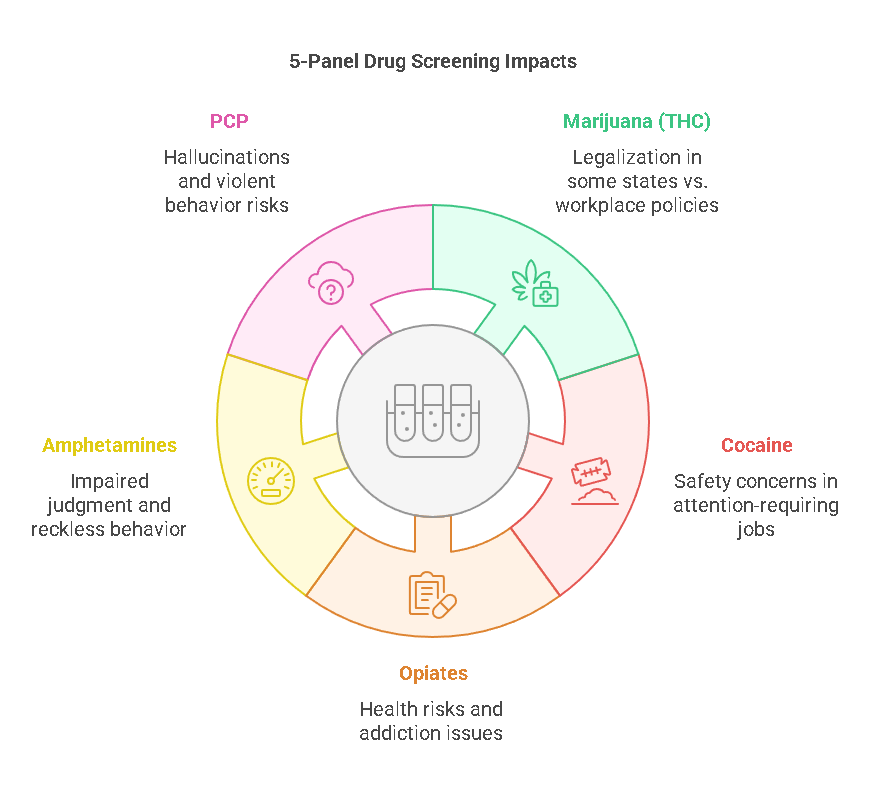
A 5-panel drug screening typically detects five major categories of drugs. These are the substances most commonly tested for in various environments, particularly in employment and safety-sensitive positions. Here is a closer look at the substances commonly included in a 5-panel drug test:
- Marijuana (THC)
Marijuana is one of the most widely used illegal substances, and its use is often tested for in the 5-panel drug screen. The test identifies tetrahydrocannabinol (THC), the psychoactive component of marijuana. While marijuana use has been legalized in many states for medicinal and recreational purposes, employers may still enforce drug-free workplace policies that prohibit its use during work hours or while performing job-related tasks. - Cocaine
Cocaine is a powerful stimulant that is commonly tested for in employment drug screenings. This drug can cause serious physical and psychological harm, and its use is illegal in most parts of the world. Cocaine abuse is particularly concerning in industries where employees must operate vehicles, machinery, or perform other tasks requiring full attention and focus. - Opiates
This category tests for a range of substances derived from opium, such as heroin, morphine, and codeine. Opiates are highly addictive, and their use is often associated with significant health risks. In the workplace, the presence of opiates can signal potential impairment and raise safety concerns. Testing for opiates ensures that employees are not under the influence of these substances while on the job. - Amphetamines
Amphetamines, including methamphetamine (meth), are central nervous system stimulants that can lead to impaired judgment, hyperactivity, and reckless behavior. Methamphetamine abuse is particularly concerning in safety-sensitive jobs that involve the operation of heavy machinery, driving, or other high-risk activities. Testing for amphetamines helps ensure that employees are not under the influence of these substances when they report for work. - Phencyclidine (PCP)
PCP, also known as “angel dust,” is a dissociative drug that can cause hallucinations, violent behavior, and severe health issues. Although less commonly abused than other drugs on the panel, its use is still a serious safety concern, especially in environments where employees must perform high-risk tasks. PCP can severely impair an individual’s ability to perform normal functions, and its detection through drug screening can help protect both the worker and others.
How Each Substance Is Tested in a 5-Panel Drug Screening
The method of testing used for a 5-panel drug screening can vary depending on the type of test being conducted (urine, saliva, hair, or blood). However, urine tests are the most common method. In a typical urine-based test, the sample is collected from the individual and sent to a laboratory for analysis. The lab performs tests to detect metabolites of the drugs in the urine, which are byproducts that remain in the body after the drugs have been processed.
Other testing methods include:
- Saliva testing: This method is less invasive and provides a quick result, often used for roadside testing. It can detect recent drug use, typically within a few hours to a couple of days.
- Hair testing: Hair tests can detect drug use over a longer period, often up to 90 days. Hair samples are typically analyzed for traces of drugs that have entered the bloodstream and become embedded in the hair.
- Blood testing: Blood tests are highly accurate but less commonly used due to their invasive nature. They can detect substances in the bloodstream and give an immediate reading of current impairment.
Advantages of 5-Panel Drug Screening
There are several reasons why the 5-panel drug screening is so commonly used in workplaces, particularly in safety-sensitive environments. Some of the advantages of using this method over other testing methods include:
- Cost-Effectiveness
The 5-panel drug test is one of the most affordable drug screening methods available. It’s particularly popular among employers who need to conduct regular screenings but also want to keep costs low. Due to its simplicity and efficiency, 5-panel drug screening is a budget-friendly choice that provides essential results without breaking the bank. - Reliability and Simplicity
One of the main reasons for the 5-panel drug test’s popularity is its reliability. It tests for the most common drugs that pose safety risks in the workplace, and it is generally considered accurate in detecting the presence of these substances. The test is straightforward, easy to administer, and yields results that are clear and easy to interpret. This simplicity reduces the risk of errors during testing, making it a trusted option for employers and regulatory authorities. - Quick Results
Many 5-panel drug tests offer quick turnaround times for results, especially when conducted using urine samples. Employers can often expect to receive results within a few business days. This promptness allows businesses to quickly take action if an employee tests positive for drugs, which is crucial in industries that rely on drug-free policies for safety. - Legal Compliance and Risk Mitigation
By implementing 5-panel drug screenings, employers can demonstrate that they are actively ensuring the safety of their workplace. It also helps organizations comply with regulations in safety-sensitive industries (such as transportation and construction) that mandate drug-free work environments. Employers can mitigate the risks associated with drug use on the job by regularly screening employees and applicants for drugs. - Detecting the Most Common Drugs
The 5-panel drug test screens for the most widely abused substances, making it an effective tool for identifying individuals who may be impaired at work due to substance abuse. For employers looking for a reliable screening process, the 5-panel drug test covers the essential substances that pose the greatest safety and productivity risks in the workplace.
Precisehire’s Role in Drug Screening
Precisehire plays a key role in assisting businesses with drug screening and employee verification processes. As a provider of background check and drug testing services, Precisehire helps employers ensure that their workplaces remain safe, compliant, and drug-free.
How Precisehire Can Help:
- Streamlined Drug Testing Process
Precisehire offers a seamless drug testing process that helps businesses implement 5-panel drug screenings efficiently. The company provides comprehensive drug testing services, including sample collection, laboratory testing, and result reporting. Precisehire ensures that all tests are conducted in accordance with industry standards and legal regulations, so businesses can rest assured that their screenings are accurate and reliable. - Compliance with Industry Regulations
In certain industries, employers are required to conduct regular drug screenings to comply with state and federal regulations. Precisehire is well-versed in the compliance requirements for industries such as transportation, healthcare, and construction. They help businesses navigate these regulations and ensure that their drug testing policies are up to date and fully compliant. - Confidentiality and Accuracy
With Precisehire’s services, businesses can be confident that their employees’ drug test results are handled with the utmost confidentiality and accuracy. Precisehire ensures that results are reported promptly and are kept private, maintaining the integrity of the testing process. - Expert Support and Guidance
In addition to drug testing, Precisehire also offers expert guidance on best practices for maintaining a drug-free workplace. They provide customized recommendations based on the unique needs of each organization, ensuring that companies are able to implement effective drug testing policies that meet both their business goals and legal requirements.
By partnering with Precisehire, businesses gain access to comprehensive drug testing solutions, which include not only the 5-panel drug test but also other screenings that may be necessary for their industry. Precisehire’s expert services enable companies to maintain safe and compliant work environments, protecting both their employees and the company from the risks associated with drug use.

